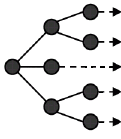



A disassembly shop order is an electronic document that authorizes the disassembly of items. You use a disassembly shop order when you disassemble items and remove the identified component parts. When a disassembly shop order is created, position parts are used as placeholders for the real parts that will be identified during the disassembly process. As parts are received from the shop order, real part identification and tracking information is recorded.
A disassembly shop order is similar to a standard shop order. The primary differences are:
Within the maintenance, repair and overhaul (MRO) process, the disassembly shop order is followed by disposition shop orders for the removed components or more disassembly shop orders if further disassembly is required.
The following table summarizes the different types of MRO shop orders, so that you can better understand how disassembly shop orders fit into the MRO manufacturing process.
| MRO Order Structure |  |
 |
 |
 |
| Type of MRO shop order | Disassembly | Disposition | Repair | Assembly |
| Source of material | Work order for overhaul object or previous disassembly order | Disassembly order | Disposition order | Inventory, disposition order, or repair order |
| Expected output | Components identified to be disassembled and remainder of overhauled part | Disposition lines identifying what is to be done with the parts (receive or scrap) and repair orders | Repaired part | Overhauled object or reassembled component |
| Position parts/Identified real parts | Created for position parts, results in identified real parts | Created for position parts, assigned real parts after the parts are identified, results in real parts | Real parts throughout | Created initially for position parts, assigned real parts after the parts are identified |
Disassembly shop orders are generated either during the initial work scope process or during work scope reevaluation. The work scope re-evaluation might discover that further disassembly is necessary. The disassembly shop order is created with the Disassembly shop order type and is allocated the position part to be disassembled. The shop order products to be received are the components identified to be disassembled and the remainder of the overhauled part. When the disassembly shop order is created, the system creates the material requirements for the item to be disassembled and schedules the operations. The material requirement is the part to be disassembled and the operations are from the order structure based on the work scope.
The status of the shop order identifies where the disassembly shop order is in the disassembly process. It also controls what you can do with the disassembly shop order.
About Shop Order describes the statuses for manufacturing shop orders. The following table summarizes the disassembly shop order statuses:
| Status | Description |
| Planned | The same as for other shop orders. |
| Parked | The same as for other shop orders except that when the Maintenance Repair and Overhaul supply type is entered, the material is not unreserved when the repair shop order is parked. |
| Released | The same as for other shop orders. |
| Reserved | Essentially the same as for other shop orders. The position part or parts to be disassembled have been reserved to the disassembly shop order. This is the status you will normally see first. |
| Started | Essentially the same as for other shop orders. Work has been started or parts have been issued to the disassembly shop order. |
| Closed | The same as for other shop orders. |
When you disassemble an item, you must perform the following tasks:
The items received will move into an inventory location. The received items will be allocated to another disassembly shop order if the items require further disassembly. If the item requires no further disassembly, it will be allocated to a disposition shop order.
If an unexpected part is reported found during disassembly, a reevaluation of the work scope will be required. The additional part could require different modifications or have different amount of life remaining.
The remainder of the disassembled part is automatically assigned to the corresponding assembly shop order used to reassemble the part.